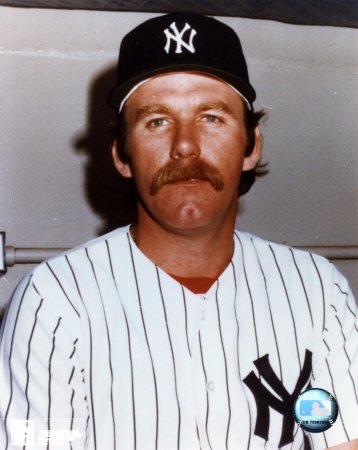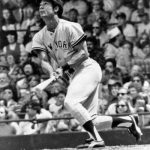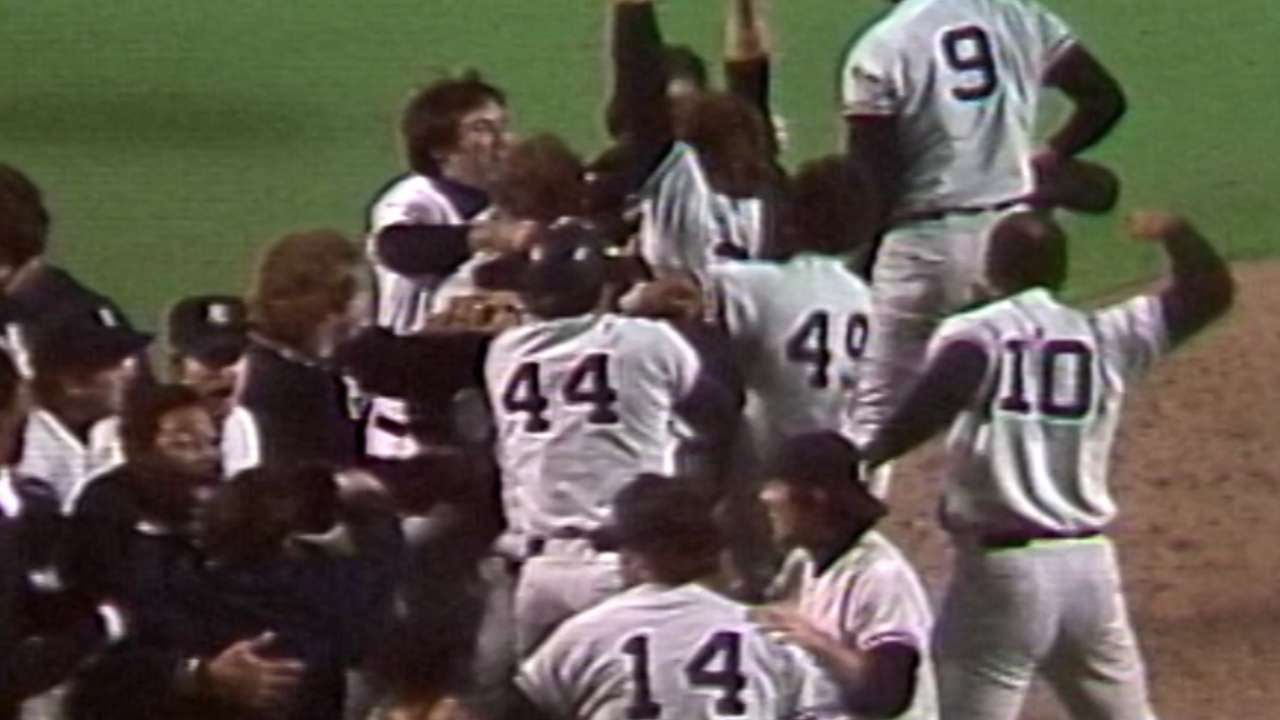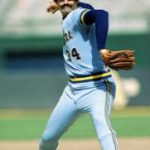Sparky Lyle Stats & Facts
Sparky Lyle
Position: Pitcher
Bats: Left • Throws: Left
6-1, 182lb (185cm, 82kg)
Born: July 22, 1944 in Du Bois, PA
High School: Reynoldsville-Sykesville HS (Reynoldsville-Sykesville, PA)
Debut: July 4, 1967 (12,605th in major league history)
vs. CAL 2.0 IP, 1 H, 3 SO, 1 BB, 0 ER
Last Game: September 27, 1982
vs. SEA 1.2 IP, 2 H, 0 SO, 0 BB, 0 ER
Full Name: Albert Walter Lyle
Nicknames: Sparky or The Count
View Player Info from the B-R Bullpen
View Player Bio from the SABR BioProject
Nine Players Who Debuted in 1967
Reggie Jackson
Graig Nettles
Rod Carew
Johnny Bench
Tom Seaver
Jerry Koosman
Amos Otis
Sparky Lyle
Aurelio Rodriguez
Notable Events and Chronology for Sparky Lyle Career
Sparky Lyle
One of baseball’s first true closers, Sparky Lyle differed from other outstanding relief pitchers who preceded him in that he was bred exclusively for work as a reliever. While previous standouts such as Hoyt Wilhelm, Joe Page, and Lindy McDaniel all served as starters at some point during the early stages of their respective careers, Lyle never started a single game in the major leagues. After first coming up with the Boston Red Sox in 1967, Lyle ended up rivaling Rollie Fingers as the finest closer of the ensuing decade after being dealt to the New York Yankees prior to the start of the 1972 campaign. Lyle saved more games than any other pitcher during the 1970s, becoming the first reliever to win his league’s Cy Young Award in 1977.
Born in DuBois, Pennsylvania on July 22, 1944, Albert Walter Lyle grew up in nearby Reynoldsville. Lyle, whose father worked as a carpenter and contractor, and whose mother served as a seamstress at a coffin factory, attended Reynoldsville High School, where he played varsity football and basketball. He began playing American Legion baseball for the DuBois team during the spring of his junior year because neither his high school nor Reynoldsville fielded an organized baseball squad.
Featuring a fastball, curveball, and changeup in his early years as a starting pitcher, Lyle once struck out 31 batters while working 14 innings in a state tournament game for DuBois. The left-handed hurler’s success at the American Legion level eventually earned him a tryout with the Pittsburgh Pirates, who elected to sign the harder-throwing Bruce Dal Canton instead. Baltimore Orioles scout George Staller also expressed interest in Lyle, though, finally signing the 19-year-old pitcher to an amateur free agent contract on June 17, 1964.
Working both as a starter and as a reliever in his first professional season, Lyle split the 1964 campaign between the Bluefield Orioles and the Fox Cities Foxes – Baltimore’s Midwest League affiliate. Selected by the Boston Red Sox in the first-year draft on November 30, 1964, Lyle spent the next 2 ½ years working his way up the Red Sox farm system. He picked up the slider, which eventually became his signature pitch, while at Pittsfield in 1966. Lyle later credited Ted Williams with introducing him to the pitch at spring training prior to the start of the season. Lyle recalled, “He (Williams) told me it was the best pitch in baseball because it was the only pitch he couldn’t hit even when he knew it was coming.”
Called up by the Red Sox in the middle of the 1967 campaign, Lyle helped the team capture the American League pennant by saving five games during the season’s second half, while compiling an outstanding 2.28 ERA in his 27 relief appearances. He established himself as Boston’s top reliever the following year, compiling a record of 6-1, saving 11 games, and posting a 2.74 ERA. Lyle saved 53 more games for the Red Sox over the next three seasons, before being traded to New York for infielder Danny Cater at the conclusion of the 1971 campaign.
Lyle developed into arguably baseball’s best relief pitcher in New York, leading the American League with 35 saves in 1972, while winning another nine games and pitching to a brilliant 1.92 ERA, en route to earning a third-place finish in the league MVP voting. Lyle’s 35 saves established a new American League record at the time. Although he pitched less effectively the following year, the left-handed reliever still managed to place among the league leaders with 27 saves. Lyle returned to top form in 1974, winning nine games coming out of the bullpen, compiling a 1.66 ERA, and being selected to the A.L. All-Star Team for the second of three times. After struggling somewhat in 1975, Lyle helped the Yankees capture the first of three straight American League pennants the following year by topping the junior circuit with 23 saves, while posting an exceptional 2.26 ERA. Lyle had his finest season in 1977, though, compiling a record of 13-5, along with 26 saves and an ERA of 2.17, en route to becoming the first relief pitcher ever to win the A.L. Cy Young Award. He also made arguably his most memorable pitching performance in that year’s playoffs.
With New York trailing Kansas City two-games-to-one in the ALCS and facing elimination, Lyle replaced faltering Yankee starter Ed Figueroa in the fourth inning of Game Four. The eventual Cy Young Award winner pitched the final 5 2/3 innings of the contest, allowing the Royals no runs on only two hits, to preserve New York’s 6-4 victory. Lyle then worked another 1 1/3 scoreless frames the very next day during the Yankees’ 5-3 come-from-behind victory that propelled them into the World Series. After excelling against the Dodgers during the World Series, Lyle ended the postseason with a record of 2-0 and an ERA of 0.96 in just over nine innings of work.
In spite of Lyle’s magnificent 1977 campaign and his heroic efforts during the postseason, Yankee owner George Steinbrenner elected to pursue free-agent closer Rich Gossage when he became available at the end of the year. Although popular opinion suggested that the addition of Gossage would likely give New York the most dynamic one-two bullpen combination in history, the arrival of the flame-throwing right-hander all but signaled the end of Lyle’s time in New York. Assigned a far less prominent role in the Yankee bullpen, Lyle served primarily as Gossage’s set-up man, turning over to the latter the more prestigious role he held the previous six years. Lyle’s diminished position in the bullpen hierarchy prompted teammate Graig Nettles to quip during the 1978 campaign that the reliever went “from Cy Young to sayonara.” Even though Lyle finished the season with a record of 9-3, he saved only nine games while posting a somewhat atypical 3.47 ERA. With Lyle no longer a major part of the team’s future plans, the Yankees included the 34-year-old reliever in a huge 10-player deal with the Texas Rangers at the end of the year that netted them Dave Righetti. Lyle spent two years in Texas, before moving on to Philadelphia and Chicago, never again achieving the same level of success he had in New York. He retired at the conclusion of the 1982 campaign with 238 career saves, which placed him second only to Rollie Fingers on the all-time list at the time.
In addition to being one of the finest relief pitchers of his time, Lyle was also one of the most charismatic. Shortly after he joined the Yankees in 1972, he established a ritual in his home ballpark of entering games to the tune of Pomp and Circumstance. The reliever then threw down his warm-up jacket upon reaching the infield and strode to the mound in a menacing manner, with a huge chaw of tobacco protruding from his jaw. Yankee fans loved Lyle’s performance, which soon became akin to a theatrical event.
Possessing the perfect make-up for a top relief pitcher, Lyle remained un-phased by even the most dire set of circumstances, and he had the swagger and self-confidence that all closers need, as well as the guts of a riverboat gambler. He also had a tremendous slider that completely neutralized right-handed hitters. While Lyle threw his best pitch with less velocity than teammate Ron Guidry, it broke down-and-in to right-handers just as sharply. In fact, Guidry developed the pitch that eventually made him an extremely successful hurler with Lyle’s help.
American League batters marveled not only at the movement Lyle had on his signature pitch, but, also, at the level of success he achieved despite lacking an overwhelming arsenal of pitches. Former outfielder Tom Grieve said of the reliever, “For a guy that really didn’t have an exceptional fastball, he saved a lot of games with guts, determination, and a hard slider that he could throw to right-handed hitters.”
Willie Randolph said of his former teammate, “I never faced Sparky, but I know he had to be hellacious. You knew the slider was coming, but you still could hardly hit it.”
Randolph added, “He had ice water in his veins; he didn’t care; he left it on the field and had a good time doing it.”
Another thing Lyle had was an outrageous sense of humor. A noted clubhouse prankster, Lyle soon developed a reputation for sneaking into the locker room during games to sit naked on birthday cakes prepared for teammates, thereby leaving the imprint of his posterior on the frosting. He noted in his autobiography, though, that teammate Ron Swoboda once turned the tables on him by defecating on a cake that was then delivered to Lyle.
However, Lyle pulled his most elaborate prank early in spring training one year. Having had little or no contact with most of his teammates the entire off-season, the reliever encased his left arm in a cast before entering New York’s spring training complex. The Yankee manager and players initially felt a considerable amount of consternation when they first saw Lyle approaching, since they realized so much of the team’s success depended on the reliever’s left arm. They soon broke into laughter, though, when they considered the source of their anxiety.
After Lyle’s time in New York ended, he co-authored a book with writer Peter Golenbock in 1979 called The Bronx Zoo. The work discussed many of Lyle’s former Yankee teammates, and it also enlightened readers as to much of the insanity that occurred within the Yankee organization during his tenure with the team. Although his book was not considered to be nearly as controversial as Jim Bouton’s Ball Four, it presented an interesting insight into some of the characters on the Yankee teams of the 1970s, and into some of the relationships between certain members of the organization.
Lyle stayed away from baseball for several years after retiring as an active player in 1982. However, he returned to the game in 1998 to manage the Somerset Patriots, a minor league team based in Bridgewater, New Jersey. Lyle continues to serve the team in that capacity, making him the only manager the team has had since its inception.
@ET-DC@eyJkeW5hbWljIjp0cnVlLCJjb250ZW50IjoicG9zdF90YWdzIiwic2V0dGluZ3MiOnsiYmVmb3JlIjoiTGVhcm4gTW9yZSBhYm91dCB0aGUgdGVhbXMsIHBsYXllcnMsIGJhbGwgcGFya3MgYW5kIGV2ZW50cyB0aGF0IGhhcHBlbmVkIG9uIHRoaXMgZGF0ZSBpbiBoaXN0b3J5IC0gLSAtIC0gLSAtIC0gIiwiYWZ0ZXIiOiIiLCJsaW5rX3RvX3Rlcm1fcGFnZSI6Im9uIiwic2VwYXJhdG9yIjoiIHwgIiwiY2F0ZWdvcnlfdHlwZSI6InBvc3RfdGFnIn19@
Factoids, Quotes, Milestones and Odd Facts
Played For
Boston Red Sox (1967-1971)
New York Yankees (1972-1978)
Texas Rangers (1979-1980)
Philadelphia Phillies (1980-1982)
Chicago White Sox (1982)
Awards and Honors
1977 AL Cy Young
Post-Season Appearances
1976 American League Championship Series
1976 World Series
1977 American League Championship Series
1977 World Series
1978 American League Championship Series
1981 National League Division Playoffs
Notes
When Lyle would enter games for the Yankees, the sound system in Yankee Stadium would blare “Pomp and Circumstance.”
All-Star Selections
1973 AL
1976 AL
1977 AL









